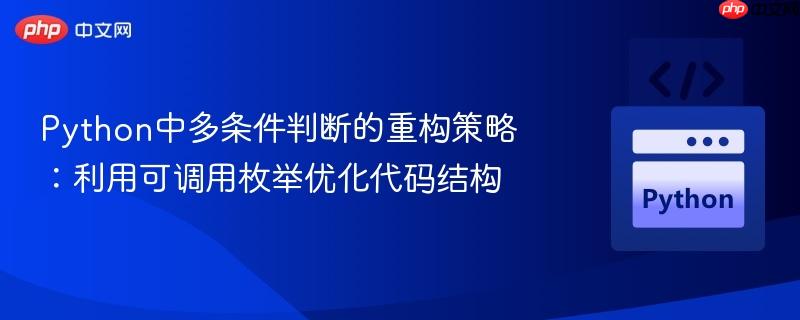
本教程探讨如何通过利用 python `textchoices`(或其他枚举类)的可调用特性,有效 重构 和简化代码中常见的多个 `if` 语句链。我们将展示如何将每个条件的具体逻辑 封装 到枚举成员对应的方法中,从而消除视图层面的冗余判断,提高代码的可读性、可维护性和扩展性。
在 软件开发 中,我们经常会遇到需要根据某个特定值执行不同操作的场景。当这些值是有限的、预定义的集合(例如状态、类型或过滤器)时,一种常见的实现方式是使用一系列 if-elif-else 语句或多个独立的 if 语句来处理每种情况。然而,随着条件数量的增加,这种模式会导致代码变得冗长、难以阅读和维护,并增加了未来扩展的复杂性。
初始问题:冗余的条件判断
考虑以下一个典型的 python Django 视图示例,其中 SomeView 需要根据 request.GET 参数中的 fields 列表来返回不同的计数数据。每个 field 对应 CounterFilters 枚举中的一个成员,并需要执行不同的计算逻辑。
from django.db.models import TextChoices from rest_framework.response import Response class CounterFilters(TextChoices): publications_total = "publications-total" publications_free = "publications-free" publications_paid = "publications-paid" comments_total = "comments-total" votes_total = "voted-total" class SomeView: def get(self, request, format=None): user = request.user response_data = [] if "fields" in request.query_params: fields = request.GET.getlist("fields") for field in fields: if field == CounterFilters.publications_total: response_data.append({"type": CounterFilters.publications_total, "count": "some_calculations1"}) if field == CounterFilters.publications_free: response_data.append({"type": CounterFilters.publications_free, "count": "some_calculations2"}) if field == CounterFilters.publications_paid: response_data.append({"type": CounterFilters.publications_paid, "count": "some_calculations3"}) if field == CounterFilters.comments_total: response_data.append({"type": CounterFilters.comments_total, "count": "some_calculations4"}) if field == CounterFilters.votes_total: response_data.append({"type": CounterFilters.votes_total, "count": "some_calculations5"}) return Response(response_data)在这段代码中,视图的 get 方法包含了一系列重复的 if 语句,每个 if 都检查 field 的值,然后执行对应的计算并构建响应数据。这种结构存在以下问题:
- 代码重复: 每次添加新的过滤器类型,都需要在 get 方法中添加新的 if 块。
- 可读性差: 随着条件增多,代码块变得冗长,难以一眼看出逻辑。
- 维护困难: 任何计算逻辑的修改都需要在视图中进行,违反了单一职责原则。
- 扩展性差: 添加或删除过滤器需要修改核心视图逻辑。
解决方案:利用可调用枚举重构逻辑
为了解决上述问题,我们可以将与每个 CounterFilters 成员相关的特定计算逻辑封装到 CounterFilters 类本身。Python 枚举类可以定义方法,甚至可以定义 __call__ 方法使其成为可调用的 对象。
立即学习“Python 免费学习笔记(深入)”;
核心思路是:
- 在 CounterFilters 类中定义一个 __call__ 方法,使其在被调用时能够根据枚举成员的名称动态地调用对应的计算方法。
- 为每个 CounterFilters 成员定义一个私有的(或命名约定上的)计算方法,例如 get_publications_total、get_comments_total 等,将具体的计算逻辑放入这些方法中。
步骤一:改造 CounterFilters 使其可调用并包含计算逻辑
我们将修改 CounterFilters 类,添加 __call__ 方法和每个过滤器的具体计算方法。
from django.db.models import TextChoices class CounterFilters(TextChoices): publications_total = "publications-total" publications_free = "publications-free" publications_paid = "publications-paid" comments_total = "comments-total" votes_total = "voted-total" # 使枚举成员可调用 def __call__(self, *args, **kwargs): # 动态获取并调用与当前枚举成员名称对应的方法 # 例如,如果枚举成员是 publications_total,它会尝试调用 get_publications_total 方法 return getattr(self, f'get_{self.name}')(*args, **kwargs) # 定义每个过滤器的具体计算逻辑 def get_publications_total(self, request): # 实际的计算逻辑,可能涉及数据库查询、外部服务调用等 # 这里仅为示例,使用固定值 print(f"Calculating total publications for user: {request.user}") return 42 def get_publications_free(self, request): print(f"Calculating free publications for user: {request.user}") return 14 def get_publications_paid(self, request): print(f"Calculating paid publications for user: {request.user}") return 25 def get_comments_total(self, request): print(f"Calculating total comments for user: {request.user}") return 1337 def get_votes_total(self, request): print(f"Calculating total votes for user: {request.user}") return 1207解释:
- __call__(self, *args, **kwargs):这个特殊方法使得 CounterFilters.publications_total 这样的枚举成员可以像函数一样被调用。
- getattr(self, f’get_{self.name}’):这是实现动态分派的关键。self.name 会返回枚举成员的名称(例如 publications_total)。我们通过 字符串 格式化构建方法名 get_publications_total,然后使用 getattr 动态获取并返回这个方法。
- (*args, **kwargs):允许我们将调用时的任何参数传递给实际的计算方法。在我们的例子中,我们将 request 对象传递给这些方法,以便它们可以访问用户、请求参数等信息进行实际计算。
步骤二:在视图中集成重构后的逻辑
现在,SomeView 的 get 方法可以大大简化,因为它不再需要显式的 if 语句链。
from rest_framework.response import Response # 假设 CounterFilters 已经定义在其他地方并导入 class SomeView: def get(self, request, format=None): user = request.user # 用户对象可能在计算逻辑中使用 response_data = [] if "fields" in request.query_params: fields = request.GET.getlist('fields') for field_str in fields: try: # 将字符串转换为 CounterFilters 枚举成员实例 _filter_enum_member = CounterFilters(field_str) except ValueError: # 如果 field_str 不是有效的 CounterFilters 值,则跳过 print(f"Invalid filter field: {field_str}") continue # 或者可以返回错误信息 else: # 调用枚举成员实例,它会根据 __call__ 方法执行对应的计算 count_value = _filter_enum_member(request) response_data.append({'type': field_str, 'count': count_value} ) return Response(response_data)解释:
- _filter_enum_member = CounterFilters(field_str):这一行将从请求参数中获取的字符串(例如 “publications-total”)转换为 CounterFilters 枚举的一个实例。如果字符串不匹配任何枚举值,将抛出 ValueError,因此使用 try-except 块进行健壮性处理。
- count_value = _filter_enum_member(request):这是重构后的核心。我们直接调用 _filter_enum_member 实例,由于 CounterFilters 中定义了 __call__ 方法,它会自动分派到例如 get_publications_total(request) 这样的方法,并返回计算结果。
优点总结
通过这种重构方式,我们获得了以下显著优点:
- 消除冗余 if 语句: 视图层面的逻辑变得极其简洁,不再有重复的条件判断。
- 提高可读性: 视图代码只关注请求处理和响应构建,具体业务逻辑被封装在枚举类中,职责分离清晰。
- 增强可维护性: 当需要修改某个过滤器的计算逻辑时,只需修改 CounterFilters 类中对应的方法,而无需触碰视图。
- 提升扩展性: 添加新的过滤器类型时,只需在 CounterFilters 中添加新的枚举成员和对应的 get_ 方法,视图代码无需任何修改,完全符合“开放 - 封闭原则”。
- 更好的代码组织: 将相关的数据(枚举值)和行为(计算逻辑)紧密地结合在一起,符合 面向对象 的设计原则。
注意事项与扩展
- 参数传递: 示例中我们将 request 对象传递给了计算方法。根据实际需求,你可以传递任何必要的参数,例如用户 ID、其他请求数据等。
- 错误处理: CounterFilters(field_str) 在 field_str 无效时会抛出 ValueError。在实际应用中,应根据业务需求妥善处理这些无效的输入,例如返回http 400 错误或简单地忽略。
- 适用性: 这种模式不仅适用于 TextChoices,也适用于标准的 enum.Enum 或任何需要根据枚举值执行不同操作的场景。
- 复杂逻辑: 如果某个计算逻辑非常复杂,可以将其进一步抽象成独立的辅助函数或服务类,并在枚举方法中调用它们。
结论
利用 Python 枚举类的可调用特性,结合动态方法分派,是重构多条件判断逻辑的一种强大且优雅的方式。它将业务逻辑从视图层解耦,极大地提升了代码的清晰度、可维护性和可扩展性,是构建健壮、可伸缩应用程序的重要技巧。通过采纳这种模式,开发者可以编写出更符合单一职责原则和开放 - 封闭原则的高质量代码。



